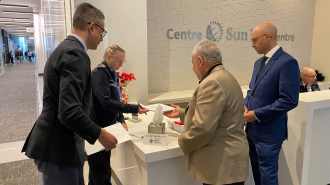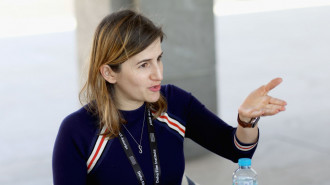
Gaza's children live in permanent state of fear as suicidal thoughts 'become common'

On a cold February morning in Rafah, Baraa Shaheen found his six-year-old brother, Nael, quivering under a truck, waiting to be run over.
Two days earlier, the house next to their tent had been bombed, scattering their family of seven.
In a light blue ragged t-shirt and trousers, Nael lay emaciated, dazed, and confused, pleading for his parents. He told Baraa he wanted to die so he could join his family, whom he thought had died.
Baraa, a trained nurse, immediately rushed Nael to Al Nasser Medical Centre and promised he would return with sweets while continuing his search for the family.
"He was thirsty and very cold. I tried to help him as much as I could," recalls Baraa.
Before Baraa could return, Nael died at the Al Nasser Medical Complex, Gaza's largest remaining hospital. Dr Kamal Hamdona said Nael had signs of severe hypothermia, which required urgent medical intervention.
The day after Nael's death, Israeli forces targeted the hospital. On February 18, the hospital ceased its operations, and Dr Kamal Hamdona went missing.
Since then, the Gaza Health Ministry has reported that Israeli forces have detained more than 100 medical professionals – their whereabouts are still unknown.
In April, a mass grave with 283 bodies, some of which were stripped naked with hands tied, was found in the hospital grounds.
Baraa found the rest of his family after his social media post on February 14 about Nael went viral. He wrote, "The child (Nael) was blue from the cold. He told me that his entire family were killed and he wanted the trailer to move and smash him so he dies and joins his deceased family."
Devastated by the news of Nael’s passing, his mother, Mona, said, "he survived, then he went away."
"He was beautiful. He loved to play football and race. He loved to eat meat which we were deprived of from the beginning of this war," says Mona, speaking from her cramped tent in Rafah, southern Gaza.
"My situation is so catastrophic, I cannot bear what is happening," she adds.
"The sounds of war, such as explosions, jets, and drones, can be particularly distressing for children. Many have developed the habit of looking upward to scan the skies for incoming jets, drones or missiles"
The Shaheen family followed Israel’s "evacuation orders," and were uprooted several times in search of safety until they arrived in Rafah, where at least 1.5 million people are sheltering.
Overcrowding, bombing, malnutrition, disease and poor sanitation are rampant.
Even before October 7, a psychotherapist in Gaza, Dr Mustafa Elmasri, noted "an alarming increase in children who were suicidal and self-harming."
"Four or five-year-olds would climb a high building, others would run in front of fast-moving cars, and some would lie under a parked car," he says, describing accounts of some of the patients he has treated.
Today, more than a million children are living in temporary shelters in Rafah where Israeli Prime Minister Benjamin Netanyahu has vowed to invade.
"The sounds of war, such as explosions, jets, and drones, can be particularly distressing for children. Many have developed the habit of looking upward to scan the skies for incoming jets, drones or missiles," says Dr Elmasri.
The exact numbers of suicidal cases among children in wartime are hard to establish but Dr Elmasri says, "talk about death, dying and suicidal thoughts is common among very young children and has got worse since the war."
"Gazan children are living in a permanent state of fear, with a sense of betrayal by adults or protectors, and a perception of the world being inherently dangerous"
Young children have watched their parents being killed in front of them by Israeli forces, others saw siblings killed in their sleep.
Dr Elmasri, who previously worked in Cambodia, Algeria, and Sudan, says Gazan children are living in a permanent state of fear, with a sense of betrayal by adults or protectors, and a perception of the world being inherently dangerous.
Some who have lost entire families hallucinate and talk to the deceased. Others scratch themselves and hurt their heads.
A new acronym, Wounded Child No Surviving Family, has been coined to highlight the high number of injured children in Gaza without surviving family members. UNICEF estimates that at least 17,000 children in the Gaza Strip are unaccompanied or separated. The actual number could be higher, aid groups warn.
Ammar Ammar, UNICEF’s Middle East and North Africa communications chief, estimates that the entire 1.1 million population of children in Gaza needs urgent mental health and psychosocial support.
Before the current fighting, half of the million children required mental health support due to Israel’s 17-year blockade of the Gaza Strip and different forms of violence.
Through specialist teams in Gaza, Ammar says anecdotally, he is hearing an increase in children as young as five expressing suicidal thoughts. Concrete data is hard to obtain.
In Rafah, Ghada Oudah shares a tent with her nephews between the ages of 3 and 13. The children were orphaned after their parents were killed, along with her niece, aged 10. She says the bodies of her deceased family members are still under the rubble where they were killed in the north.
Ghada, a former international NGO worker, says there are "many cases of children who suffer from traumatic stress. Some have lost their entire families, are still in shock and can’t speak." Her nephews wet the bed and have suffered hair and speech loss.
Ghada moved from the north to the south and got separated from her daughters, aged eleven and nine. The couple are divorced, and the father has been looking after the girls. She longs to reunite with her daughters and fears they don’t have enough to eat.
Currently, children have no access to specialised health services. Only 12 of the 36 health facilities are partially functioning. Ammar says the only psychiatric hospital in the Gaza Strip was ravaged, and six other mental health clinics on the Strip are not accessible.
UNICEF runs some projects and activities with service providers. They have trained some staff in shelters to help children and parents deal with trauma. But it is not enough, warns Ammar.
Against a sea of white tents in Rafah, acrobats dressed in bright orange, with red noses from the Free Gaza Circus, somersault, play tricks, pull funny faces and organise games.
Children paint their faces, interact with the performers, and laugh in a brief respite from the bombing and grief which has consumed them for months.
In 2018, Free Gaza Circus was founded to provide a safe environment to engage the youth in creative arts in a safe space.
After seven months of bombing, Israeli forces have obliterated its building, and the whereabouts of hundreds of children who acquired circus crafts and skills — are unknown.
Despite the struggles, the circus artists and acrobats provide psychological support. Mohammed Khader, the group’s founder says it is their "passion project, their calling, their artistic purpose."
"The depression of this situation can be unbearable. At least the children have something to let them smile a few days per week — whenever it is possible," says Mohammed.
Charlene Rodrigues is a Journalist whose written work and photography have been published in The Guardian, Al Jazeera, Middle East Eye, The Economist, International Business Times, and others
Follow her on X: @Piccolinanne






 Follow the Middle East's top stories in English at The New Arab on Google News
Follow the Middle East's top stories in English at The New Arab on Google News


